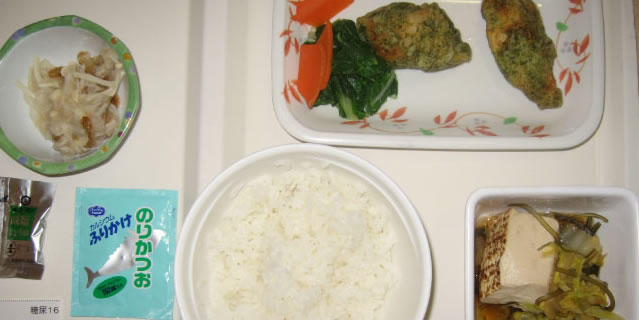Gourmand Dietary Culture
- TOP
- ESSAYS
- Gourmand Dietary Culture
- Michelin Stars for Hospital Food?
Michelin Stars for Hospital Food?
vesta No. 72
Inoki mushrooms with grated daikon, soy, and vinegar seasoning (left-hand small bowl); reduced-salt soy sauce; rice-seasoning [furikake]; rice; fried cod (top right); fried tofu, string kelp, white rape boiled in soy sauce (bottom right). All plastic food.
I had to stay in hospital for 8 days for a small operation. For the day of the operation, I didn't eat, but after that I was given hospital food. I was put on a diet for diabetics, as I have developed mild diabetes through my job working with food. Usually, I'm a heavy drinker and smoker, but I was a model patient while in hospital and cut out both.
To give you an example of one of the breakfast menus.
Porridge
Seaweed boiled in soy sauce [nori tsukudani] (sold in single portion-sized small plastic bags)
Boiled Japanese mustard spinach and carrot (boiled vegetables with hardly any dashi or salt taste)
Milk (180ml carton)
Baby cheese (one slice of processed cheese wrapped in aluminium foil)
In nutritional terms, this is a balanced meal, but culturally, I felt resistant to being given porridge, milk and cheese.
So, let's take a look at a dinner menu next.
Rice (there was a card next to it saying: that day they had used 10g of flour, so rather than 200g of rice, there was 175g of rice).
Fried cod (2 fillets with no salt or pepper seasoning, fried in a parsley batter. They seem to have reduced the rice quantity because of the small amount of flour in the batter).
Thinly sliced spinach and carrot boiled, as a garnish.
Fried tofu, string seaweed, white rape boiled in soy sauce (no taste of seasoning).
Inoki mushrooms with grated daikon, soy, and vinegar seasoning.
Seaweed [nori] and bonito rice-seasoning [furikake].
Reduced-salt soy sauce (again in a single portion packet).
There was no taste of seasoning in this meal. For the patient's health, they try to completely reduce the amount of salt used in cooking. When flavour is lacking, they add some packets of reduced-salt soy sauce and rice-seasoning [furikake]. Of all of the 19 meals I ate in hospital, I can't say that I found a single one delicious; they were all cooked as nutritionally balanced, for balance's sake.
When I had a more serious operation on my ankle in 2003, I spent a month in a different hospital. It was a well-reputed hospital with a number of well-known doctors, but the hospital food was, again, pretty awful. Among the patients of orthopaedic surgery who I befriended in the canteen, there was a dignified older man called Ms. Ama. Even Ms. Ama, who seemed like he might have already transcended the five desires of Buddhism, expressed the following thoughts:
"In the month I've spent in hospital, I only once thought some grilled fish was delicious. All of the other food has been unpleasant. It seems like the people cooking the food have a dull palette. It's miserable at the end of your life, to have to feel disappointed every day by the food. You feel like as soon as you're released, absolutely anything will taste delicious.
[This section is reprinted from the "Hospital Diary of a Gourmand" in Japan's Table: Food East and West (Heibonsha, 2006)]
It's a mistake to wish for delicious hospital food. In fact, you could say that it's common knowledge that hospital food is not delicious. But for the patients in hospital, meals are about all they have to look forward to. It should be that--while my health problem is under control--I'm given such delicious food, that I don't want to be discharged from the hospital. The hospital menu is usually created by the head nutritionist of any given hospital. Hospital food might be good in terms of its nutritional content, but no thought is given to the taste. There's no practical training in cooking as part of the national exam for nutritionists. It would be good if nutritionists worked together with talented chefs to design the food menu. When you think of doctors' salaries, the cost of employing chefs seems comparatively unimportant.
Most Japanese hospitals deny the patients much pleasure. In most hospitals, irrespective of the health problem, smoking and drinking is banned. They are sacred grounds where even smokers and drinkers are coerced into abiding by the rules. I usually take a good hour and a half to enjoy my dinner with a drink, but in hospital, where drink was banned, I'd finish dinner in 20 minutes. In the past, it was normal to give patients gifts of grape wine. Even the emperor is known to have offered grape wine at the bedside of a senior statesman. In France, they ask whether patients would prefer red or white wine with their meal.
Delicious hospital food would surely speed the recovery of patients. When someone has to spend a long time in hospital, the kind of meals they'll get fed, likely affects their choice of hospital. It's the same thing when choosing an old people's facility. I think we should grade the quality of food in places like hospitals and orphanages, to create something like a hospital food Michelin Guide. But how could we gather that information, I wonder?
Translated with support by Agency for Cultural Affairs, Government of Japan

